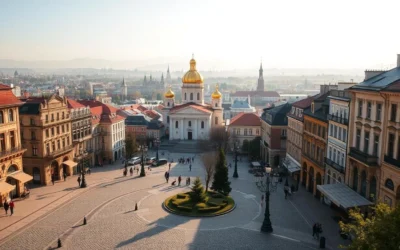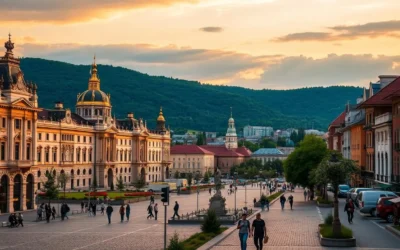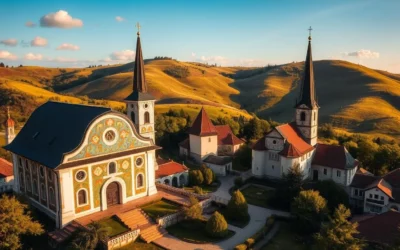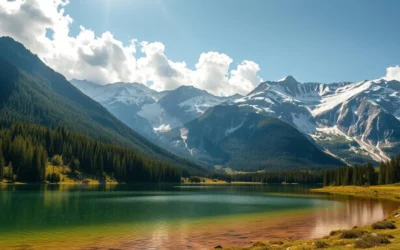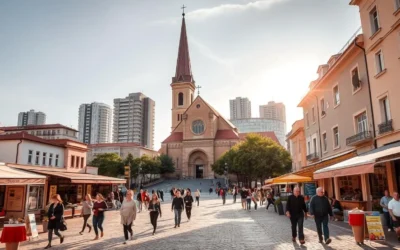Surprising fact: more than 200,000 people attend the city’s summer festivals each year, turning squares and parks into open‑air stages.
You will get a fast, friendly snapshot that helps you plan without feeling overwhelmed.
Start with a walkable route that links squares, churches, galleries, and a key museum. The compact layout makes it easy to visit main attractions in one day or stretch them over a relaxed weekend.
Expect a lively university vibe that shapes coffee culture, street food, and late‑night patios. You’ll also see a rich mix of architecture—from Gothic spires to Secession facades—and public art around nearly every corner.
We’ll point out where to pause in a shaded park or quiet garden, which museums pack the most punch, and how low‑cost flights make the city a smart base for Transylvania day trips.
Why Cluj‑Napoca Is Worth Your Time Right Now
Expect a friendly, energetic atmosphere where theater, festivals, and coffee culture meet historic streets.
Creative university vibes and friendly local life
You’ll feel the creative pulse immediately thanks to a huge student population that fuels cafés, galleries, and nightlife.
Locals are open and chatty—meet people at terraces, markets, or during a festival and you’ll quickly feel welcome.
Transylvania hub for culture, history, festivals, and architecture
The place doubles as a cultural hub with major events like Untold, Electric Castle, and TIFF drawing visitors worldwide.
Layered history and beautiful architecture sit side by side, from old theaters to lively public squares.
- Mix headline attractions with spontaneous local moments—buskers, pop‑ups, and cafés.
- Sample multicultural menus at neighborhood restaurants and theaters in several languages.
- Plan around festivals if you crave energy, or pick shoulder season for quieter streets and easy reservations.
Choose places to stay near the center so you can visit most sights on foot and leave time for detours. Map clusters of sights each day, then add a flexible evening for galleries, music, or casual bites.
Start in the Heart: Avram Iancu Square and Iconic Architecture
Begin your day at Avram Iancu Square, where sweeping views put a grand cathedral and historic statue side by side.
The square anchors the Orthodox Dormition of the Theotokos Cathedral, completed in 1933. Step inside the church and you’ll spot Brâncovenesc and Byzantine details that explain a chunk of local history.
Opposite, the National Theatre and the Romanian National Opera stand as landmark buildings. Their façades show Habsburg and Hungarian influences—Renaissance, Baroque, and Secession—creating a patchwork of beautiful architecture.

Use this space for a short walking tour. Frame photos that place the cathedral’s domes against the theater’s ornate frontage. The square is also ideal for people-watching; seasonal stalls and small events make it lively between other attractions.
- Start your walk at Avram Iancu Square for a one-stop panorama.
- Note Renaissance, Baroque, and Secession touches if you love architecture.
- Plan an evening performance for a culture-first night in the city.
Walk Eroilor Boulevard to Union Square for History, Art, and People‑Watching
Follow Eroilor Boulevard as it hums with cafés, historic façades, and steady city life on the way to Union Square.

St. Michael’s Church and the Matthias Corvinus Monument
Step into Union Square and let St. Michael’s Gothic tower draw your eye while the Matthias Corvinus Monument anchors the plaza. The square often hosts events, so arrive early if you want wide, unobstructed shots.
Photogenic façades dating back to the 15th century
Look up for ornate details on buildings dating back to the 15th century. Slow walking rewards you with unexpected courtyards, murals, and small galleries that add to the area’s rich history.
- Stroll Eroilor Boulevard for café life and terrace snapshots.
- Pause at terraces near the Old Town Hall for espresso and people-watching.
- Use golden hour for dramatic photography of the church and monument.
- Duck into side streets for quieter views, art installations, and hidden restaurants.
- Keep this node in mind as you move on to parks, river paths, or nearby museums; it’s easy for tourists to navigate.
Slow Down in Parcul Central and Along the Someș River
Parcul Central sits along the Someș river and is the ideal spot when you want to trade busy streets for green shade and slow rhythms.
Circle Chios Lake, watch ducks, and then pick a table at the lakeside restaurant for a relaxed brunch. The classic park ambiance makes it easy to sit and soak in local life.
Use the river promenade as your walking route. It links neighborhoods and offers calm river views and small, scenic spots that locals love.
Pack a simple picnic and join people sprawled on the lawns. In season, street food stalls sell langos and kürtőskalács—perfect park snacks while you wander.
Swing by the nearby Hungarian Theatre for a quick cultural peek, and note that parts of the park close during the Untold Festival. Check closures and choose quieter hours if you prefer fewer crowds.
- Relax: ponds, lawns, and a garden-like feel beside the water.
- Walk: riverside promenades make a pleasant route between attractions.
- Wrap up: finish with a sunset amble as the city softens into evening.
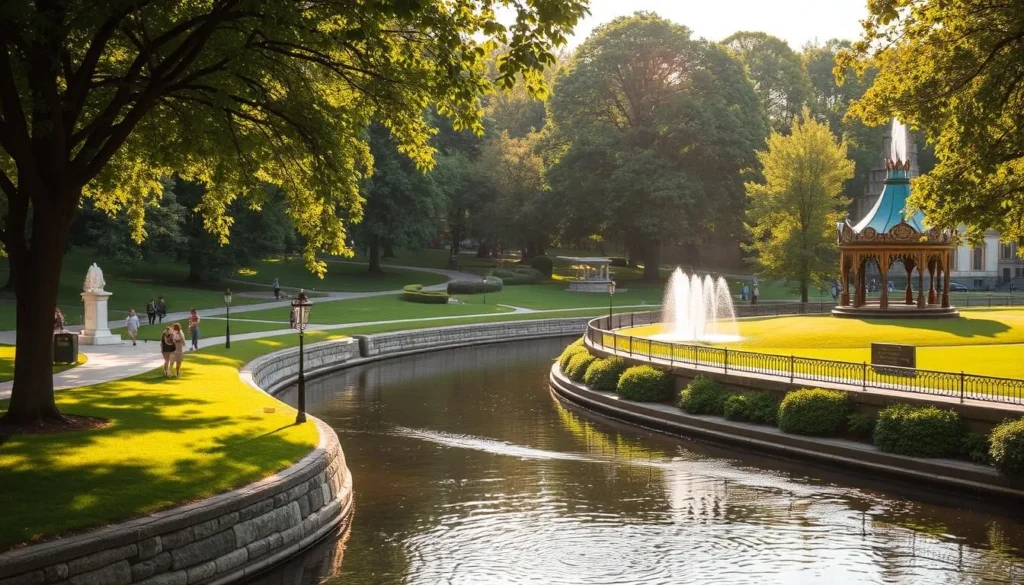
Best City Views from Cetățuia Hill
Head up Cetățuia Hill near sunset for sweeping panoramas that show the whole city spread below.
You can climb the stairs or take a quick rideshare part-way and enjoy a short walk through Cetățuia Park to the top. The route is a relaxed little tour and it opens into wide views that photographers love.

Bring a light layer; breezes pick up as you linger. Scout different ledges—some frame the arena and river bends, others focus on church spires and squares. This lookout is a favorite spot for tourists and locals alike.
- Pace yourself: stairs have plenty of rest points and photo angles.
- Time it: golden hour to blue hour shows landmarks and bridges in great light.
- Save steps: rideshare to the upper entrance if your schedule is tight.
Wrap this ascent into a walking route from Parcul Central along the Someș for a scenic approach. Keep night-safety common sense and use your phone’s night mode for crisp city lights shots.
Cluj‑Napoca, Romania: Best Things to Do – Top Picks
Begin your downtown loop with a compact route that ties historic squares, leafy parks, and a few key museums into one easy walk.
Start at Avram Iancu Square and follow Eroilor Boulevard toward Union Square. This tight circuit groups core attractions so you can visit many spots without long transfers.
Add a restful stop at Parcul Central for shade and people-watching before you climb to the Cetățuia Hill viewpoint. The mix of open air and viewpoints makes the day feel balanced.
Slot in the Botanical Garden for calm color, or choose a nearby museum if the weather turns. For meals, pick a terrace around Union Square or Piața Muzeului where many restaurants serve flexible options.
- Loop: Avram Iancu → Eroilor → Union Square for your first stack of must-see things.
- Break: Parcul Central as your park pause, then finish with Cetățuia Hill at sunset.
- Swap: Botanical garden for calm, or a museum for a rainy-hour plan.
- Consider a short guided tour if you want quick local context.
Mix indoor and outdoor stops to keep energy steady and capture the city in different light. Slow walking helps you notice markets, pop-up performances, and café detours that many tourists miss.
![]()
Museums You’ll Actually Love: History, Art, and Local Life
Museums here mix everyday life with art and archaeology, so you can move from folk farms to fine paintings in one easy day.
The Transylvanian Museum of Ethnography splits its displays between Reduta Palace downtown and the outdoor Romulus Vuia site. Start at Reduta Palace for textiles, tools, and built displays that show rural lifeways.
Romulus Vuia (the ethnographic park romulus) is an open‑air village with mills, farms, and wooden churches. Budget extra time there—note that romulus vuia closes in winter (Nov–Apr).
H3: Ethnographic Museum stops
- Pair Reduta Palace with the ethnographic park romulus for a full picture of tradition.
- Wander wooden structures and compare regional building styles and craft techniques.
Archaeology and Fine Art
The National Museum of Transylvanian History traces timelines with artifacts dating back to Dacian roots. Then step into Bánffy Palace for the National Art Museum’s deep collection—over 12,000 works in a landmark building on Unirii Square.
Don’t miss niche spots like the Pharmacy History Museum and Muzeon for personal stories. Use museum cafés and courtyards as gentle pauses between galleries as you explore the city.

Sacred Spaces: Churches and Synagogue with Powerful Stories
Quiet streets near the old museum quarter hide a cluster of sacred spaces that map the city’s layered past.
Franciscan Church in Museum Square
Step into the Franciscan church in Museum Square and you’ll feel medieval layers beneath your feet. Built between 1260–1290, this building rests over earlier sites and holds ornate altarpieces that whisper local history.
St. Michael’s Gothic Masterpiece
Stand beneath St. Michael’s soaring nave for a pure Gothic hit. This church has anchored civic life for centuries and played roles in political rites and wartime sermons.
Reformed Church: Concerts and Acoustics
On Mihail Kogălniceanu Street, the Reformed Church is famed for its sound. Time a concert and you’ll hear choral music lift in a space prized for its acoustic clarity. It’s an ideal stop for curious tourists and those who love live music on a short cultural tour.
Neolog Synagogue: Moorish Beauty and Living Memory
The Neolog Synagogue shows Moorish lines and careful restoration. It survived attacks in 1927 and wartime damage, then became a memorial that keeps remembrance active in a living community. Look closely at façades and chapels; each site tells a different chapter in religious and architectural life.
- Visit during quiet hours to study frescoes and stained glass.
- Ask about restoration phases and how each space serves congregations today.
- Combine these stops with Museum Square dining for a compact, respectful route through sacred architecture.

Botanical Garden Bliss: 10,000+ Species, Seasonal Color, and Serene Paths
A calm maze of paths and seasonal color awaits you at the city’s 14-hectare botanical garden.
The living collection spans more than 14 hectares and includes over 10,000 species. Spring is prime: the Rosarium and beds burst with over 40,000 tulips.
Start at the Rosarium for intense seasonal blooms. Then wander into the Roman Garden for classical layouts and stone accents.

Japanese Garden, Roman Garden, and Rosarium highlights
Seek quiet moments in the Japanese Garden where water reflections and trimmed plantings invite slow breaths. This spot is ideal for a reflective pause and light photography.
The Roman Garden offers formal lines and a sense of history, while the Rosarium shines with layered colors in spring and late summer.
- Make time: budget 1.5–2 hours to wander the themed landscapes and small paths.
- Bring a camera: this park ranks high for both macro shots and sweeping scenes.
- Visit the museum: the on-site botanical museum rounds out the collection and deepens context for plant lovers.
- Plan your timing: arrive early or late to avoid crowds and enjoy the garden’s full beauty.
Entry is modest, and pairing the garden with a nearby café makes a gentle break before you return to other attractions around the city.
Museum Square Evenings: Traditional Romanian Food and Historic Ambiance
Museum Square after dark feels like a living postcard—terraces glow and conversations drift across the plaza.
Settle into Piața Muzeului and you’ll find cobblestones, strung lights, and a lineup of cozy restaurants. Places like Casa Veche serve long-simmered dishes that taste like a local home recipe.
Order traditional romanian plates—try varza a la Cluj alongside familiar classics—to sample the city’s comfort food in one sitting. Pick a terrace table to soak up evening life and the slow cadence that makes dining here feel ritualized.
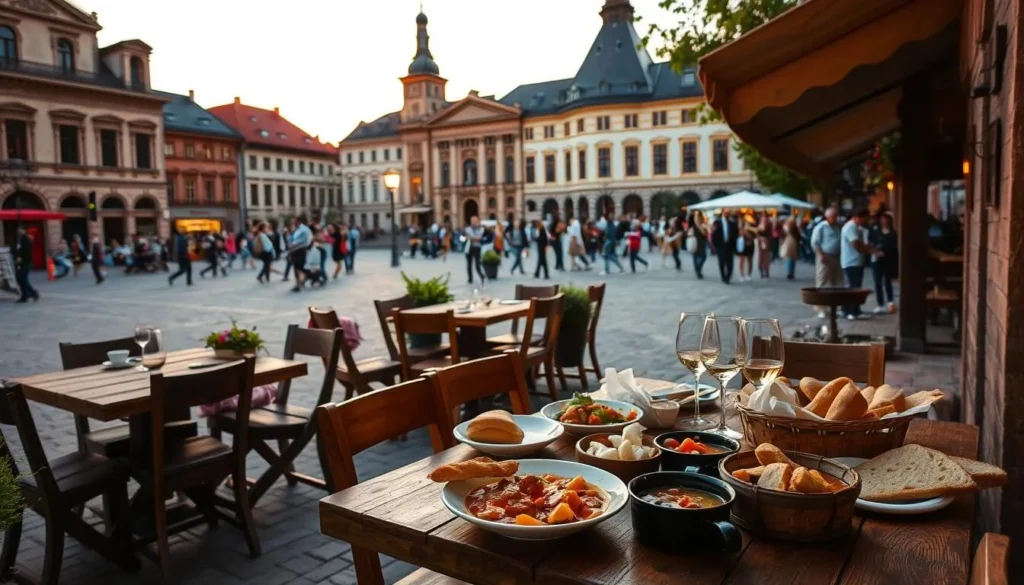
- Walk: it’s a short stroll from parcul central and avram iancu if you want a pre- or post-dinner amble.
- Ask: servers for house specialties—kitchens often reinterpret regional recipes.
- Wander: side alleys when the main run is busy; quieter tables hide charming façades.
Time your table for twilight to catch the square shifting from daytime bustle to evening glow. Tourists often return more than once—so don’t be surprised if you do, too. Finish with a digestif at a nearby wine bar and watch the last tables linger under the lights.
Art Galleries, Photography Spots, and Contemporary Culture
Find contemporary art in intimate spaces that turn opening nights into lively neighborhood gatherings.
Drop into Plan B, Bázis, and Lateral ArtSpace for rotating exhibitions that highlight local and regional artists. These small venues focus on current ideas, experimental shows, and projects that change frequently.
Ask about opening nights. You’ll often meet artists and curators, and the events feel like social fieldwork in the heart of the creative scene.
Street‑level Photography and Urban Texture
Train your lens on façades, church towers, and quietly ornate courtyards. The old town’s dense details make casual photography a rewarding, day-long hobby.
Peek into courtyards where restored building elements sit beside everyday life. Morning light brings crisp lines; afternoon warmth softens stone and stucco.
- Pair gallery stops with nearby cafés to compare notes and mark favorite places on your map.
- Keep an eye out for pop-up installations along walking routes and public squares.
- If you’re new, ask gallerists for under‑the‑radar suggestions; they point you toward raw studio spaces and small shows.
Mix museums with a raw gallery visit in one afternoon for contrast. Return after dark and you’ll see the same architecture reframed by streetlamps and spotlighted towers—another great view for visitors.
Markets, Flowers, and Local Makers
Weekend markets and maker stalls bring color and music to a narrow street that’s easy to wander on foot.
Wander Strada Potaissa for the Altfel Flower Market, active Fri–Sun (10–23) in warm months. The place fills with bouquets, potted herbs, and micro‑performances that show everyday maker life in the city.
Workshops let you meet artists and learn quick skills, while small stalls sell home pieces that travel well. Vehicle traffic is often restricted during the market, so add this stop to your walking route for easy access and a relaxed pace.
Seek artisan fairs such as ZAIN for a deeper look at local designers and craftspeople shaping new aesthetics. If you like slow shopping, arrive early or loop back after lunch; stalls and vendors often rotate.
- Wander Strada Potaissa for a weekend market stop on your tour.
- Pick up blooms, herbs, or small home souvenirs that carry memory.
- Ask vendors about sourcing and traditions; stories make finds meaningful.
Combine market time with Museum Square dining nearby for a balanced afternoon that mixes attractions and easy social life for tourists.
Festival Season: Untold, Electric Castle, and TIFF
Feel the city shift gears in summer when music, film, and night life take over streets and parks.
Plan your summer visit around festival season to see major cultural life at full tilt. Untold (August) fills Cluj Arena and the adjacent park areas; book stays early and bring earplugs if you sleep near the center.
Electric Castle (July) happens at Bánffy Castle in Bonțida, where the centuries‑old building frames ten stages and late‑night sets across the grounds. TIFF runs in late July/early August and uses multiple venues, from courtyards to rooftops, for intimate screenings.
- Use festival apps to track stages, lineups, and last‑minute schedule changes.
- Check bracelet perks—Untold sometimes offers discounts at other attractions and destinations.
- Pack flexible clothes for sun and rain; castle grounds can get muddy after showers.
- Book restaurants and transport early, and build downtime into your tour to recover between late nights.
If you prefer quieter visits, aim for the shoulder days right before or after the peak to enjoy energy without the biggest crowds. Festivals reshape the place; they’re a lively way for tourists to see modern culture and local history mix in one summer run.
Day Trips That Wow: Castles, Canyons, and Underground Worlds
A short drive opens a world of medieval fortresses, limestone gorges, and glowing salt caverns worth a full-day outing.
Turda Salt Mine feels otherworldly. You can walk vast cavern halls, ride small boats on the underground lake, or try mini golf and table tennis under dramatic lighting. The mine’s air is famously fresh, so bring a light layer and plan early to beat crowds.
Corvin Castle & Alba Iulia pair well in one loop. Corvin delivers medieval drama while Alba Iulia’s Vauban-style citadel stacks military history into a tidy, walkable route. It’s an efficient way to see strongholds and civic fortifications in one day.
Escape next to Rimetea village with its whitewashed houses, then hike the Turda Gorges for limestone walls and river crossings. Venture into the Apuseni Mountains for beginner-friendly cave and forest hikes that reward you with wide valley views.
Bánffy Castle sits on restored grounds and feels quiet on non-festival days. It’s the place where Electric Castle transforms the estate into a music park each summer, but alone it offers calm walks and good photo ops.
- Book a day tour if you want tight logistics and storytelling; self-drive is straightforward but longer.
- Start early, pack layers (caves stay cool), and bring snacks and water for rural stretches.
- Aim your camera at limestone textures, turret silhouettes, and sweeping valley views for a varied photo roll.
Paranormal or Just Pretty? Hoia Baciu Forest Night Tour
Head out after dusk to Hoia‑Baciu Forest for a night tour that blends eerie lore with striking photography chances.
Hoia‑Baciu has drawn attention since the 1960s for UFO reports and strange happenings. Guides frame the stories and point out the crooked trees that fuel local legend. The forest sits near the Romulus Vuia open‑air ethnography park, so you can do daytime visits and return after dark.
Guides often bring EMF meters and Geiger counters, making the walk playful even for skeptics. Wear sturdy shoes and bring a headlamp—trails are uneven and your hands will be busy with camera gear.
Practical notes:
- Sign up with a licensed group—many visitors prefer guided safety on night walks.
- Keep noise low and lights down to protect night vision for everyone.
- Ask before using bright flashes so others can capture the same shots.
- Combine a daytime park visit at Romulus Vuia with the evening forest tour.
Whether you call it haunted or just pretty, the forest offers moody scenes and a unique slice of local life. Plan for chilly temps under the canopy and celebrate later in the city with a late bite and shared stories.
Eat, Sip, and Go Out: Where to Taste Cluj’s Food and Nightlife
Food and nightlife meet easily here, so you can plan coffee hops, a cultured evening, or a late cocktail crawl without long walks.
Traditional Romanian dishes to try: varza a la Cluj and more
Start with varza a la Cluj, a baked cabbage-and-meat casserole that anchors a short list of traditional romanian flavors. Follow it with a hearty soup, grilled plates, and flaky pastries for variety.
For dinner, book a table at Museum Square’s Casa Veche or pick a Union Square restaurant for lively terraces. By day, coffee culture rules—student hangouts on Piezisa Street fuel long chats with friends.
| Name | What to Try | Vibe | Best Time |
|---|---|---|---|
| Casa Veche | Varza a la Cluj, slow lamb | Historic building, cozy terrace | Evening, weekends (reserve) |
| Piezisa cafés | Espresso, pastries | Student energy, casual | Midday–late afternoon |
| Union Square terraces | Seasonal plates, local wine | Social, walkable after-dinner | Dinner, after-opera nights |
- Coffee hop by day, cocktail crawl by night—old town blocks pack cafés and bars into a short grid.
- Pair an opera or ballet night with a slow dinner near the Hungarian Opera for cultured life and good conversation.
- Choose restaurants in buildings with character—vaulted rooms or courtyard windows add ambiance like a home visit.
Conclusion
Wrap up your trip by letting the city’s compact layout guide easy walks between parks, museums, and viewpoints. You’ve got a clear plan to visit a compact center that delivers big on culture, food, and easy‑going life. Start in the squares, drift through a garden and quiet streets, and let hilltop views and standout buildings round out your days.
Fold in seasonal festivals or day trips to nearby destinations like the Turda Salt Mine and Corvin Castle for a dose of the wider world. Balance marquee things with slow moments in neighborhoods and markets. Use public spaces as your living room—this place invites wandering, lingering, and leaving with a longer list of spots you’ll return to soon.
The above is subject to change.
Check back often to TRAVEL.COM for the latest travel tips and deals.

